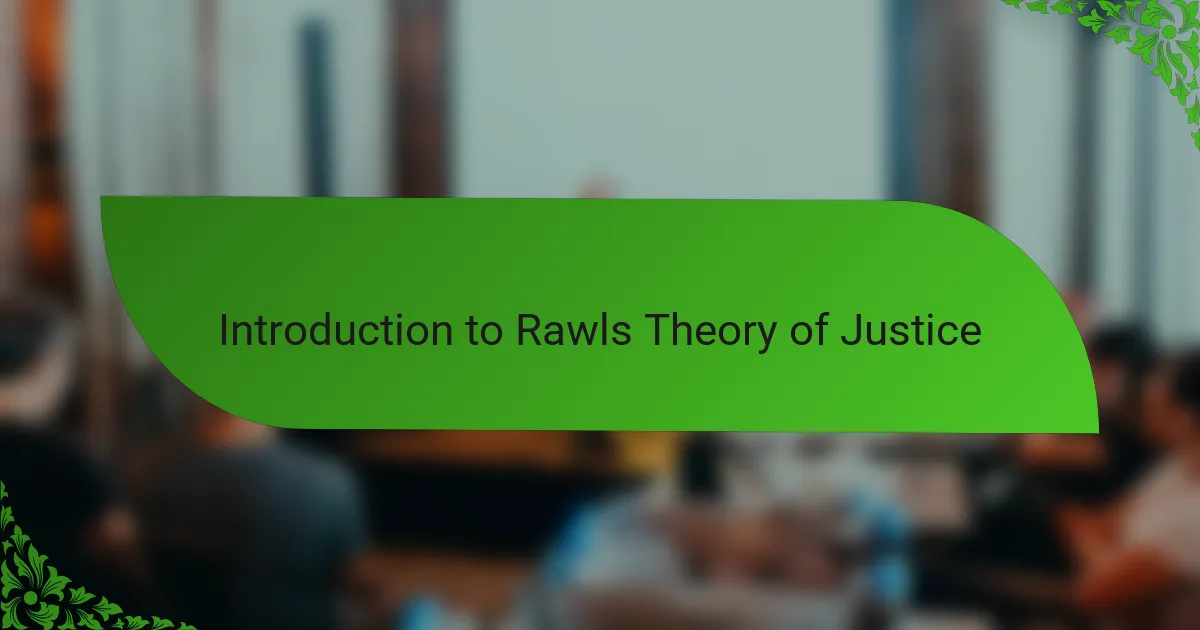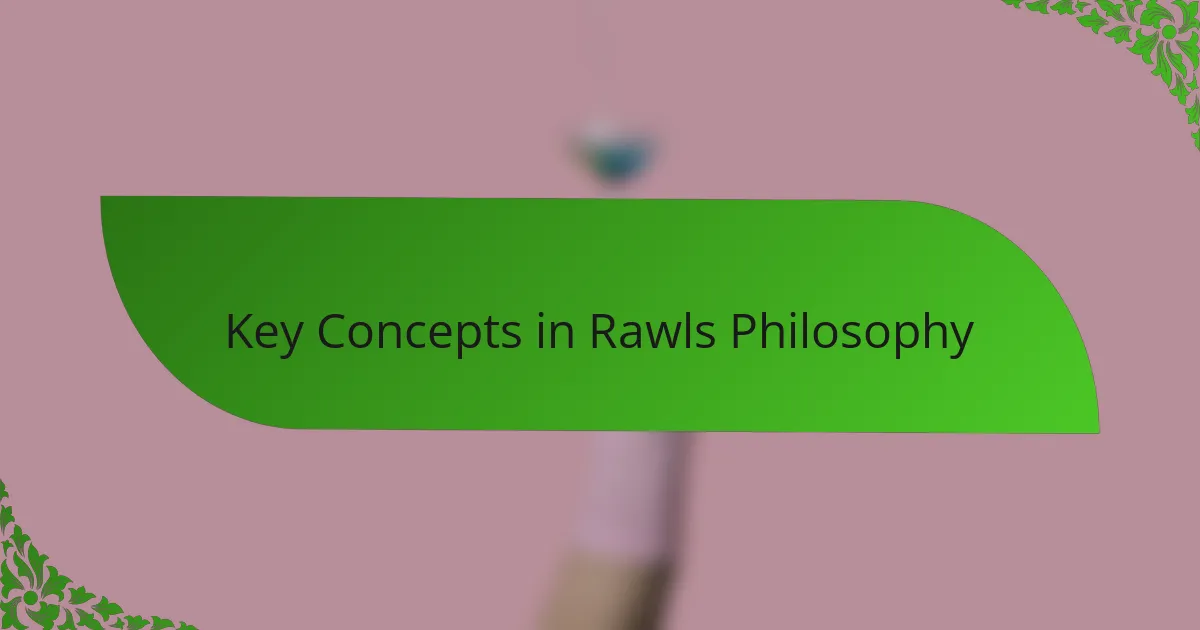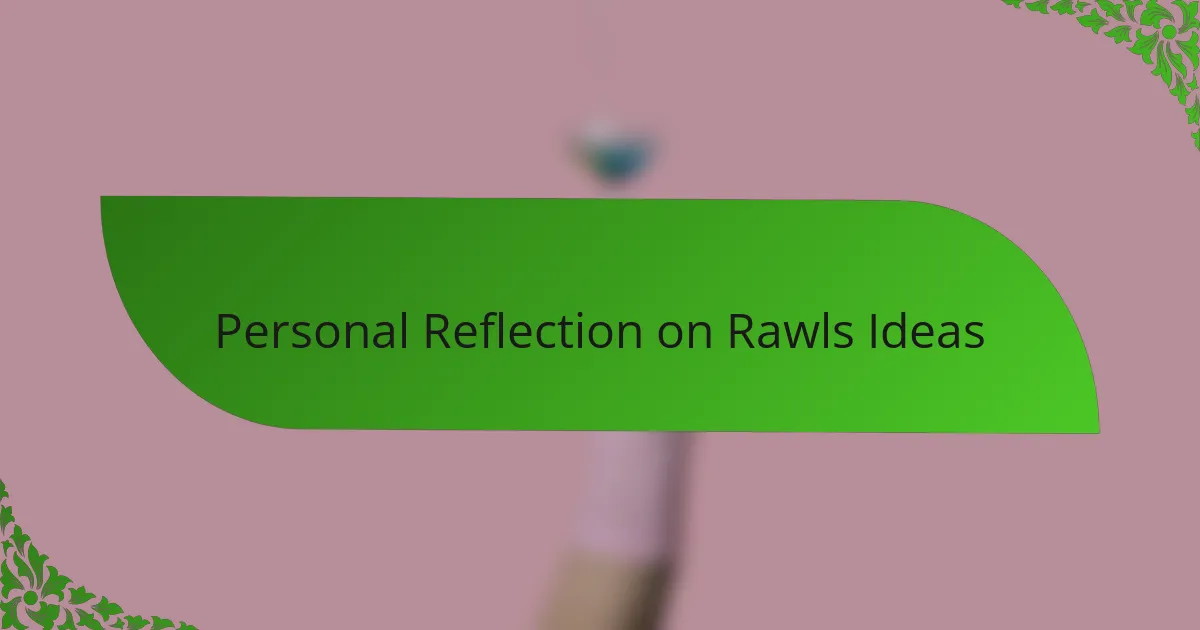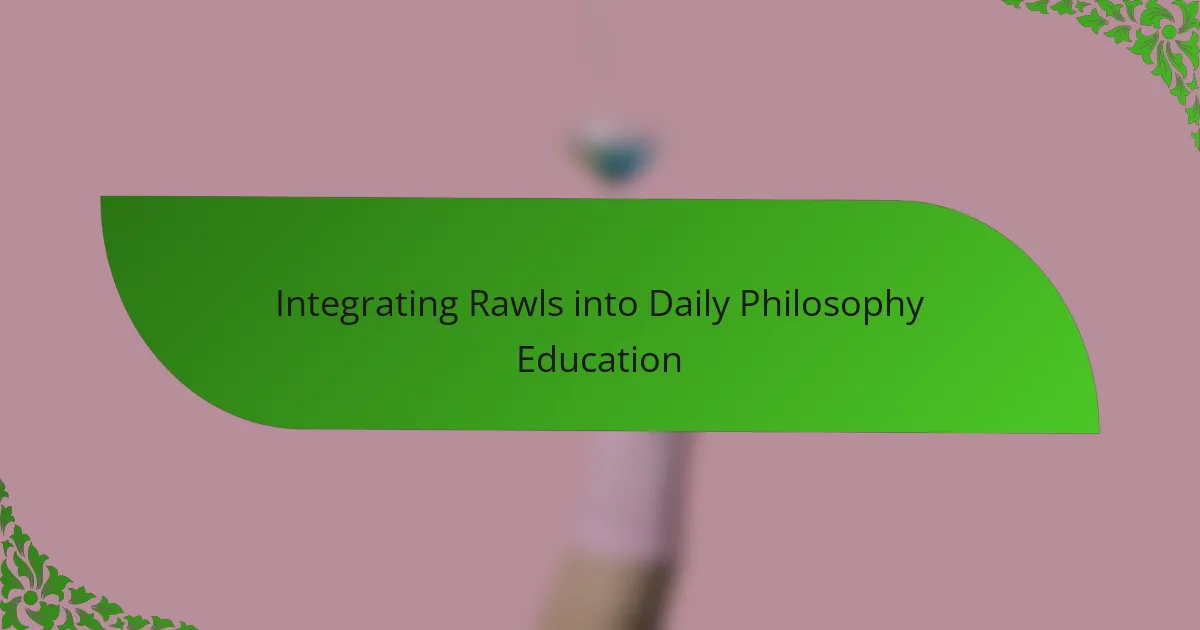Key takeaways
- Rawls’s “original position” and “veil of ignorance” promote the idea of designing a fair society by removing personal biases from decision-making.
- The two principles of justice—equal basic liberties and the difference principle—emphasize the balance between individual rights and the well-being of the least advantaged.
- Applying Rawls’s theory in education encourages fairness by prioritizing resources for disadvantaged students and fostering an environment of respect for individual voices.
- Understanding and integrating Rawls’s concepts into discussions encourages critical thinking about justice, fairness, and the complexities of real-world inequalities.

Introduction to Rawls Theory of Justice
When I first encountered Rawls’s Theory of Justice, I was struck by its underlying question: How can we design a fair society when none of us knows our position within it? This idea of the “original position,” where decision-makers operate behind a “veil of ignorance,” fascinated me because it challenges our natural biases. Have you ever considered how different your choices would be if you didn’t know whether you’d be rich or poor, powerful or marginalized?
What drew me deeper into Rawls’s work was his emphasis on two principles of justice—equal basic liberties for all and the difference principle, which allows inequalities only if they benefit the least advantaged. At first, I wasn’t sure how these ideas could work practically, but reflecting on them made me realize how they aim to balance freedom with fairness. It’s a delicate dance between protecting individual rights and ensuring social equity, something I find both inspiring and challenging.
Reading Rawls felt like a personal invitation to rethink justice beyond legal statutes or political rhetoric. His approach makes you ask tough questions: What would fairness look like if no one had an advantage? Can a society truly be just if some are left behind? These reflections have stayed with me, shaping my own understanding of what justice should mean in our everyday lives.

Key Concepts in Rawls Philosophy
Rawls’s key concepts really challenged how I think about fairness. The “original position” and “veil of ignorance” aren’t just abstract ideas—they forced me to imagine making decisions without knowing who I’d be in society. Have you ever tried to separate your personal interests from the bigger picture like that? It’s surprisingly humbling.
Another idea that stood out to me was the prioritization of equal basic liberties. Rawls argues these rights are non-negotiable, no matter what inequality exists elsewhere. This made me reflect on how often we take freedoms for granted until they’re threatened. Isn’t it fascinating how justice demands both individual rights and social welfare to coexist?
Then there’s the difference principle, which I found both hopeful and complex. It permits inequalities only if they improve the lot of the least advantaged. At first, I questioned whether this was realistic or just idealistic. But thinking it through, I see it as a powerful reminder that fairness involves lifting everyone up, not just balancing the scales for the majority. Have you noticed how often real societies struggle with this balance?

Applying Rawls Theory in Education
When I think about applying Rawls’s theory in education, I’m drawn to the idea of the veil of ignorance. Imagine designing a school system without knowing whether you’d be a student struggling with resources or a teacher with plenty—wouldn’t that push us toward fairness for all? This perspective challenges educators to create environments where every learner’s basic rights and needs are equally respected.
What really struck me is how the difference principle can reshape educational policies. Shouldn’t extra attention and resources go to students who are disadvantaged, so they, too, get a real chance to succeed? From my experience volunteering in diverse classrooms, I’ve seen how targeted support can transform a student’s path, embodying Rawls’s call to lift the least advantaged.
But how do we balance equality and liberty in schools? Rawls reminds me that preserving freedoms—like expression and choice—is crucial, even while striving for fairness. This tension is real in education, where discipline and structure meet diversity and autonomy. Reflecting on this, I believe true justice in education means fostering both opportunity and respect for every individual’s voice.

Personal Reflection on Rawls Ideas
Rawls’s ideas made me confront my own unconscious biases in a way I hadn’t expected. I remember feeling unsettled when I imagined making decisions behind the veil of ignorance—without knowing if I’d be privileged or marginalized. It’s a humbling exercise that forced me to reconsider what fairness truly requires.
At times, I struggled with the difference principle. Could society realistically ensure that inequalities always benefit the least advantaged? Yet, reflecting on experiences where small acts of support made a huge difference for others helped me appreciate the power of intentional justice. Isn’t genuine fairness about lifting everyone rather than just tweaking the system for the majority?
One question that keeps coming back to me is how to maintain equal basic liberties amid real-world inequalities. Rawls insists these rights are inviolable, but I’ve seen situations where rights are compromised under pressure. This tension felt deeply personal—reminding me that justice is not just a theory but a living challenge we face every day.

Challenges in Understanding Rawls
Understanding Rawls wasn’t always straightforward for me. His language is precise but often dense, making it easy to get lost in the philosophical jargon before grasping the core ideas. Have you ever found yourself rereading a sentence multiple times, only to realize you’re still not sure what it means? That happened to me more than once with concepts like the “original position” and the “difference principle.”
Another challenge was wrestling with the practical implications of his theory. It’s one thing to accept the idea that inequalities can exist if they benefit the least advantaged, but it’s quite another to imagine how that plays out in real societies. I remember questioning how any government could truly measure and prioritize the well-being of its most disadvantaged citizens without bias or error.
Finally, Rawls’s strict emphasis on equal basic liberties sometimes felt at odds with the messy realities I’ve seen in social and political life. How do you protect these rights consistently when emergencies or social pressures push for exceptions? This tension made me realize that mastering Rawls’s theory requires not just intellectual understanding but ongoing reflection on how justice works—or doesn’t—in the world around us.

Practical Lessons from Rawls Theory
One practical lesson I took from Rawls’s theory is the power of stepping outside myself to make fairer decisions. Imagining the veil of ignorance isn’t just an abstract exercise—it’s a mindset shift that can guide real choices, whether in policy or everyday interactions. Have you ever tried making a decision without thinking about how it might benefit you personally? I find that it opens up a surprising space for empathy and fairness.
Another insight that stuck with me is how the difference principle pushes us beyond simple equality. It’s not enough to give everyone the same; we have a responsibility to lift up those starting from a harder place. I recall volunteering at a community center where targeted support changed how young people saw their options—Rawls’s idea felt alive in those moments, reminding me that justice means active care, not just equal shares.
Lastly, Rawls’s insistence on protecting equal basic liberties feels like a vital anchor in a world full of competing interests. Balancing freedoms with fairness isn’t easy, but it’s necessary. When I reflect on debates around rights and social needs, I realize Rawls’s framework challenges us to hold both values tightly, even when they pull in different directions. Isn’t that the crux of practical justice—finding that delicate tension and respecting it?

Integrating Rawls into Daily Philosophy Education
Integrating Rawls into daily philosophy education feels like inviting students to put on a new pair of glasses—one that blurs personal bias and sharpens the focus on fairness. I’ve noticed when learners actively step into the original position, it sparks deeper conversations about justice that go beyond textbook definitions. Have you ever seen a classroom moment where students suddenly grasp the weight of making choices without knowing their own status? That shift is powerful.
What I find especially rewarding is weaving the difference principle into discussions about real-life inequalities. In my experience, students become more empathetic when they consider how advantages affect people differently and why policies should prioritize the least advantaged. This kind of engagement turns abstract theory into lived understanding—not just for exams, but for how they see the world.
Yet, balancing Rawls’s equal basic liberties with aspirations for social equity can be tricky to teach. I’ve often encouraged students to debate cases where freedom and fairness clash, helping them appreciate the tensions Rawls highlights. It’s through these challenging discussions that philosophy education gains its true vitality, preparing young minds to wrestle thoughtfully with justice in everyday life.